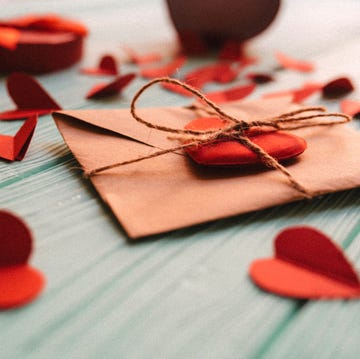Every June, the LGBTQ+ community and allies celebrate Pride Month with events, parades, marches and parties. While large cities' Pride events can garner crowds of thousands of people, it wasn't always that way. In fact, the history and origins of Pride Month date back to the 1960s — and it might shock you to learn how Pride Month began, why the iconic rainbow flag was created and more fun facts about Pride Month.
Everyone should embrace queer joy in whichever way makes them happy, but it's also important to understand why we celebrate Pride Month, what the flag represents and more. So, before you stick a rainbow pin on your Pride outfit and head to your local parade, check out these tidbits of queer history and facts about Pride Month that you never knew.
1. The Stonewall Riots inspired Pride Month
Some of you may know this one, but June was designated Pride Month because the uprising at the Stonewall Inn began on June 28, 1969. The Stonewall Inn is a gay bar in New York City that was raided by the police on that night. Police raids of gay bars were fairly common, but this event shifted the course of history. LGBTQ+ people and allies fought back against the police, which led to an uprising that lasted for six days. Thanks to the heroes of the riots at the Stonewall Inn like Marsha P. Johnson, a Black transgender woman, this event is an iconic marker in the fight for LGBTQ+ rights that helped lead the way to LGBTQ+ rights and shape the Pride Month we celebrate today.
2. The first Pride flag was Harvey Milk's idea
Harvey Milk was an activist and the first openly gay man to be elected into office in California (and one of the first openly gay elected officials in all of America). Milk was adamant on publicly advocating for LGBTQ+ rights, and he was able to help pass a gay rights ordinance that banned anti-LGBTQ+ discrimination in housing and employment in San Francisco.
While Milk significantly contributed to the LGBQ+ rights movement in a variety of ways, a less widely known fact about Milk is he sparked the idea of creating a symbol for gay pride. Milk asked artist Gilbert Baker to create a symbol, who then designed the first rainbow Pride flag in 1978 that has remained an iconic symbol representing the LGBTQ+ community for decades. To learn more about Milk, you can watch the movie named after him, Milk, which is based on the life story of Milk and his activism in San Francisco.
3. The original Pride flag had nine colors
Sad news for fans of the colors pink and turquoise: these colors were originally in the first Pride flag that Baker designed in 1978. Turquoise was removed as a design choice by Baker, but the pink stripe was removed from the design due to a lack of availability of pink fabric, which became an issue when the demand for more Pride flags increased after the assassination of Harvey Milk. This led to the creation of the most widely known Pride flag with only red, orange, yellow, green, indigo and violet.
While the six color Pride flag is still the most commonly used flag, the most recent update in the flag's design was in 2021 when the Intersex-Inclusive Progress Pride Flag was created. This flag includes a triangle on the left-hand portion of the flag to represent the communities of color, those lost during the HIV/AIDS crisis and non-binary, intersex and transgender people in the LGBTQ+ community.
You can check out all the variations of the Pride Flag over the years and learn more about each flag's history on the Human Rights Campaign's (HRC) website
4. Each color in the Pride flag has a special meaning
Speaking of colors of the Pride flag, each color has its own meaning. While this is technically a fun fact about the flag, Pride flags are waved and displayed most often in Pride Month, and it's an interesting tidbit of queer history. The meanings of each color on the six color flag are as follows:
- Red: Life
- Orange: Healing
- Yellow: Sunlight
- Green: Nature
- Indigo: Serenity
- Violet: The spirit of LGBTQ+ people
In the original flag, pink represented sex and turquoise symbolized magic and art. The newest rendition of the flag (the Intersex-Inclusive Progress Pride Flag) includes black and brown stripes to represent communities of color in the LGBTQ+ community, and the black stripe is also a nod to those lost during the HIV/AIDS crisis. The light pink and blue represents the transgender community, and the yellow triangle with a purple circle symbolizes intersex people.
5. Before Pride Month existed, there was Christopher Street Liberation Day
To commemorate the one-year anniversary of the Stonewall Uprising, the first Pride March in NYC called "Christopher Street Liberation Day" was held on June 28, 1970. Los Angeles also held a Pride celebration on the same day, but New York City's was much larger, with reports stating that the crowd of thousands covered 15 blocks. It was then celebrated annually on the last Sunday of June, and people called this by a variety of names over the years, including "Gay Pride Day."
6. President Bill Clinton declared June as "Gay and Lesbian Pride Month" in 1999
NYC has held a Pride March every year since 1970 (excluding 2020 and 2021 due to the COVID-19 pandemic) in June, which ultimately led the way for June being chosen as Pride Month. In a search through an online archive done by NBCU Academy, it was found that the first mention of "Pride Month" in a newspaper was in June 1972. "We call it Gay Pride week and Gay Pride Month, the whole month of June," gay activist Byrna Aronson was quoted. Over the years, more and more events occurred throughout the month of June in cities all across the country.
Pride Month was officially recognized by the U.S. Government in 1999, when former President Bill Clinton declared June as “Gay and Lesbian Pride Month." President Barack Obama proclaimed it as "LGBT Pride Month" in 2009 for a more inclusive name. President Joe Biden further expanded the observance to “Lesbian, Gay, Bisexual, Transgender, and Queer (LGBTQ+) Pride Month.”
So, while the weather in June is pleasant, there's more history behind the decision beyond great weather for parades!
7. More than 30 different flags represent the LGBTQ+ community
One last fact about the Pride flag: the iconic rainbow flags are umbrella flags, meaning they represent the entire LGBTQ+ community as one unit. However, there are more than 30 flags to represent the variety of sexualities, gender identities and more within the LGBTQ+ community.
The lesbian flag features hues of pink and orange while bisexuals are represented by a dark blue, pink and purple flag. The transgender flag has blue, pink and white stripes, but it can be even more specific if you want a non-binary flag (yellow, white, purple and black) or a gender queer flag (purple, white and green). There are tons more of Pride flags representing various identities that help others feel seen.
Why so many flags? Pride flags help raise awareness and show support of the community, so specific flags for each identity in the LGBTQ+ community is a way to support individual labels. Plus, for some people, it is a way to silently signal to others that they identify with a specific label in the LGBTQ+ community. Whether it's a pin on a shirt, a flag on a front door or a sticker on a water bottle, others can see that they identify as gay, a lesbian, non-binary, pansexual, bisexual, asexual, transgender or one of the many other identities.
8. The biggest Pride parade is in Brazil
The Stonewall Inn is located in New York City's West Village, but the riots sparked the LGBTQ+ rights movement in the U.S. and had major impacts around the entire world. For years, the NYC Pride March was the biggest parade for Pride around the world, but a different city claimed that title in recent years.
The largest Pride parade in the world is now considered to be Parada do Orgulho LGBTQ de São Paulo, also known as São Paulo Gay Pride. In 2024, more than 4 million people attended São Paulo Gay Pride (around 2.5 million attended the NYC Pride March), earning it the Guinness World Record title for the biggest Pride parade in the world. The turnout is even more impressive considering the event had only 2,000 participants at the first parade in 1997 — 27 years after NYC's first Pride March in 1970.
Isabella (she/her) covers commerce and product-related content in the home, lifestyle, fitness, technology and beauty. She graduated from Binghamton University in 2022 with a bachelor’s degree in English: Literature & Rhetoric. Before joining GH, she was an editorial assistant at Prevention, where she covered health topics and celebrity news.


















